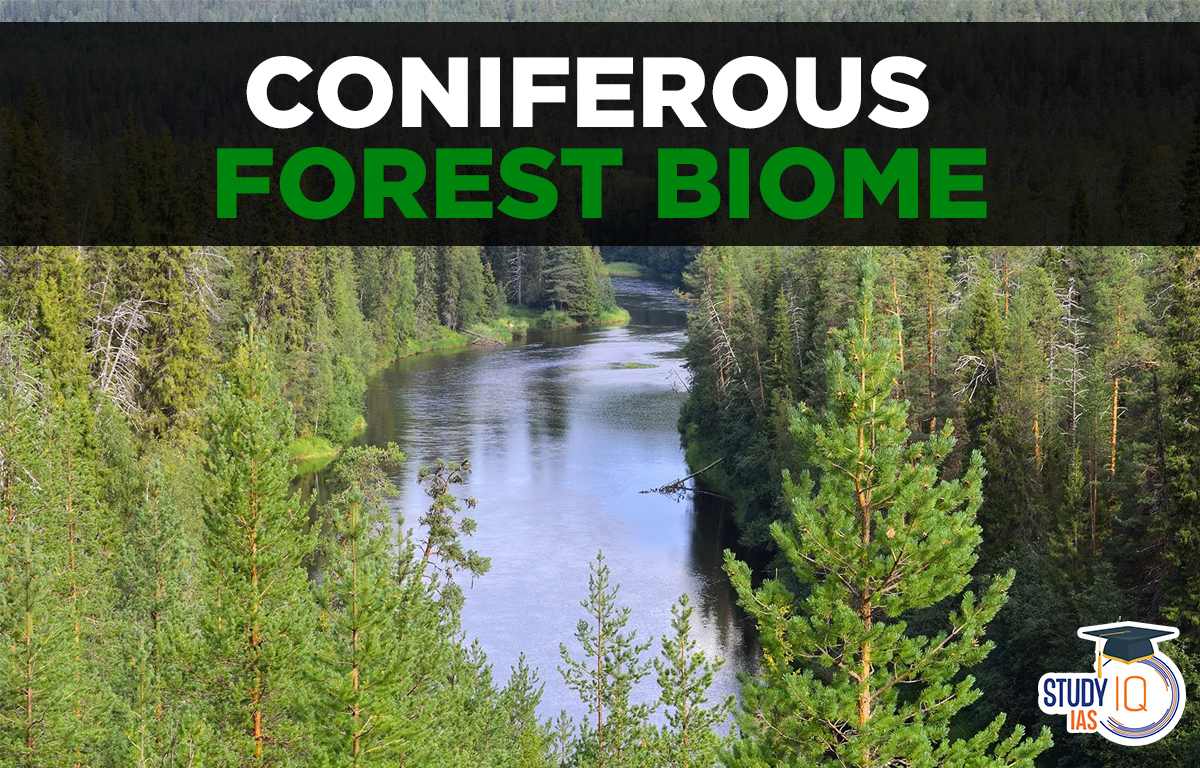Table of Contents
The Coniferous Forest Biome, often called the “taiga” or “boreal forest,” is one of the most extensive terrestrial biomes on Earth, spanning vast regions across North America, Europe, and Asia. Known for its evergreen trees and cold climate, this biome plays a significant role in the Earth’s carbon cycle and supports unique flora and fauna adapted to its harsh conditions. This article explores the characteristics, location, climate, and ecological significance of the Coniferous Forest Biome.
Coniferous Forest Biome
The coniferous forest biome is also known as the taiga or boreal forest. Boreal coniferous forests, also known as Taiga or snow forests, are evergreen forests found just south of the tundra in the Northern Hemisphere. They are the world’s second-largest biome, covering 20 million hectares and stretching continuously through Europe, Asia, and North America. These forests experience long, harsh winters and short days.
Read about: Chromite Ore
Coniferous Forest Biome Characteristics
- Flora Dominance:
- Evergreen Trees: The biome is predominantly populated by evergreen coniferous trees like pine, spruce, fir, and larch. These trees have needle-like leaves that are adapted to withstand cold temperatures, retain moisture, and resist snow accumulation.
- Adaptations: Needle-like leaves have a waxy coating, which reduces water loss. They remain green year-round, allowing photosynthesis as soon as conditions permit, an adaptation to the short growing season.
- Understory Vegetation: Due to limited sunlight reaching the forest floor, the understory is sparse, comprising mosses, lichens, and small shrubs.
- Soil Composition:
- Thin and Nutrient-Poor Soil: The soil in this biome is typically acidic due to the slow decomposition of fallen needles, which release tannins.
- Podzol Soil Type: This acidic soil, called podzol, is often low in nutrients due to leaching and is covered by a thick layer of organic matter.
- Wildlife Adaptations:
- Cold-Resistant Species: Animals like moose, wolves, foxes, lynxes, and bears are common and have adapted to the cold. Many animals have thick fur, while some hibernate during winter to conserve energy.
- Migratory Birds: Many bird species migrate to warmer areas during winter, returning in the warmer months to breed and feed.
Read about: Manganese Ore
Coniferous Forest Distribution
Due to the ability of the plants found in this forest to grow in snowy or extremely cold temperatures, the boreal forest is situated between the temperate deciduous woods on the south side and the tundra on the north. They go all over North America, halting just north of the southern Canadian border, from Alaska to Newfoundland.
Northern America
From Labrador on the east coast to Alaska on the west coast, Northern America’s boreal forest reaches. The area spans an estimated 2,000 kilometres from the north to the south of the continent. Only 11% of the boreal forest is found in America; 24% is found in Canada alone.
Asia and Europe
From Siberia to Scandinavia, the boreal forest covers most of Europe and Asia. Asia contains the largest portion of the forest, measuring nearly 3,000 kilometres from north to south. Only 4% of Sweden, Finland, and Norway’s land is covered in boreal forests, whereas 58% of it is in Russia. 3% of the forest is in China and Mongolia.
Read More: Iron Ore
Boreal Forests Abiotic Components
Abiotic elements are nonliving parts of an ecosystem that affect the environment. They cover things like the atmosphere, temperature, soil, precipitation, and others.
- Temperature:
- Cold Climate: Winters are long, cold, and severe, with temperatures often plummeting below -30°C. Summers are short and mild, with temperatures averaging 10°C to 20°C.
- Short Growing Season: The growing season is brief, usually lasting 3–5 months. Plant growth is confined to the summer months, when temperatures are above freezing.
- Precipitation:
- Moderate Precipitation: Annual precipitation varies from 300 to 900 mm, falling primarily as snow in winter and rainfall in summer.
- Snow Accumulation: Snow is an essential component, providing insulation to plants and animals and contributing to the hydrological cycle as it melts.
- Humidity and Light:
- Seasonal Variation in Daylight: The high latitudinal position of the coniferous forests results in significant seasonal changes in daylight hours, with long days in summer and prolonged darkness in winter.
- Low Humidity: Winters tend to be dry, although some moisture is retained by snow cover.
Read More: Cobalt Ore
Boreal Forests Biotic Components
Biotic factors are living things that affect an ecosystem or the creatures living there. These include producers, consumers, and decomposers. Producers, like green plants, make their own food using sunlight. Consumers, like goats, zebras, antelopes, and lions, eat producers or other animals for food. Decomposers, like bacteria, eat dead organic matter.
Read More: Minerals
Coniferous Forest
Coniferous Trees
Most trees in the boreal forest are conifers, like spruces, pines, and larches. These trees stay green to get sunlight and start making food quickly. Their leaves look like waxy needles, which helps them save water in summer and early spring. These needle-like leaves usually fall off every two to three years, but some, like spruces, can keep them for up to eight years. Some trees, like Tamarack and Larch, lose their needle-like leaves every year.
Deciduous Trees
Most deciduous trees can not grow well in the tough conditions of the boreal forests, but some can. These trees lose their leaves in the fall to save energy for the long winter. Heavy snowfall in winter can break some of their branches. Examples of shrubs are blueberries, willow, and alder. Examples of broadleaf deciduous trees are birch, poplar, and aspen.
Read More: Types of Rocks
Coniferous Forest Consumers
Mammals
- The boreal forest is home to a variety of herbivores, including moose, caribou, deer, elk, voles, muskrat, beaver, hare, mice, and the snowshoe hare.
- Herbivores have developed the ability to survive in a range of harsh environments, including hibernation.
- To defend themselves from attacks by carnivores, they have also developed camouflage.
- The hunters are well adapted to the cold and have key adaption techniques that help them get prey, as demonstrated by wolves who hunt in packs.
- In the forest, carnivores such as the fox, lynx, marten, grizzly bear, coyote, black bear, otter, shrews, cougar, ermine, and the least weasel can be found.
- Hares and lynx, for example, have fluffy feet that prevent them from sinking in the snow when running, which is another adaptation found in animals of boreal forests.
Birds
- The best times to see birds in woodlands are in the early spring and later in the summer.
- Although some birds remain throughout the entire season, the bulk migrate before the harsh winter months.
- Among the birds that can be seen in the forest in the spring are whooping cranes, ducks, Goshawks, great horned owls, ospreys, loons, shorebirds, gulls, shorebirds, warblers, and swans.
- Some species, like warblers, travel to the forest from as far away as South America, while others, like owls, only sometimes visit the habitat.
Read More: Wave Energy
Read More: Coastal Landforms
Economic Development
- Many coniferous woodlands in the northern hemisphere remain underdeveloped due to their seclusion.
- Coniferous woods in Canada, Russia, and other nations are underutilized, with significant untapped potential.
- More accessible forests are often logged on a large scale.
- Few crops can survive in the subarctic, limiting agricultural opportunities
Trapping
- Many fur-bearing animals live in the far north of Eurasia and Canada.
- Colder areas produce better and thicker fur.
- The best furs come from the coldest winters.
- Canadian trappers and hunters use automatic rifles and live in log houses in the middle of coniferous forests.
- Examples of fur-bearing animals include ermine, mink, silver fox, and muskrat.
- Fur farms in Canada and Siberia provide a steady supply of furs.
Lumbering
- This is the Siberian climate type’s primary occupation. The logging business is supported by a huge amount of coniferous forests.
- Lumberjacks: In the past, contract workers referred to as “lumberjacks” would move temporarily to forested areas to cut down trees. Trees are now cut down using machines.
- Taking to the waterways for travel The softwood logs may float down rivers with ease. Logs are therefore moved by the river to sawmills farther downstream. Logs are converted into plywood, timber, and other building materials in sawmills.
- Industry of paper and pulp: Timber is pulped chemically and mechanically to produce wood pulp. Paper and newspaper are produced from wood pulp. Newspaper and wood pulp are mostly produced in Canada and the United States of America, respectively.
- Softwood is rarely used as a fuel since its industrial applications are far more significant.
- In Sweden, matches are a significant export item used as a raw material for industry.
- In other temperate countries, wood is used to create toys, furniture, wood carvings, packing boxes, and other items.
- The by-products of the lumber are used to make a variety of chemically processed goods, such as rayon turpentine, varnishes, paints, dyes, liquid resins, wood alcohols, disinfectants, and cosmetics.
Read More: Continental Drift Theory
Ecological Importance of Coniferous Forest Biome
- Carbon Sequestration:
- The coniferous forests store vast amounts of carbon, making them crucial in controlling global climate. Trees in this biome absorb large quantities of CO₂ during photosynthesis, acting as a “carbon sink.”
- Biodiversity:
- While less diverse than temperate or tropical forests, the coniferous biome supports unique biodiversity, providing habitat for cold-adapted species and migratory birds.
- Role in Hydrology:
- The coniferous forest biome influences water cycles by trapping snow, which melts in spring and feeds into rivers and groundwater, supporting ecosystems downstream.
- Economic Resources:
- These forests provide timber, pulpwood, and other resources, making them vital for industries in countries with substantial coniferous forest cover. However, this has led to concerns over deforestation and its impact on climate.
Coniferous Forest Biome UPSC
The Coniferous Forest Biome, characterized by its evergreen trees, cold climate, and unique biodiversity, is an essential component of the Earth’s ecology. While it is threatened by climate change and human activities, conservation efforts and sustainable management practices offer hope for its preservation. Recognizing the biome’s value in climate regulation and biodiversity conservation is crucial, making it a focal area for environmental policy and global ecological health. Understanding and preserving this biome is vital, as it provides invaluable resources, regulates global carbon cycles, and supports numerous species adapted to its cold, resource-scarce conditions.


 Desert Climate, Distribution, Climatic C...
Desert Climate, Distribution, Climatic C...
 Deserts of India Map, Features of Thar D...
Deserts of India Map, Features of Thar D...
 Indus Valley Civilization, History, Phas...
Indus Valley Civilization, History, Phas...





















